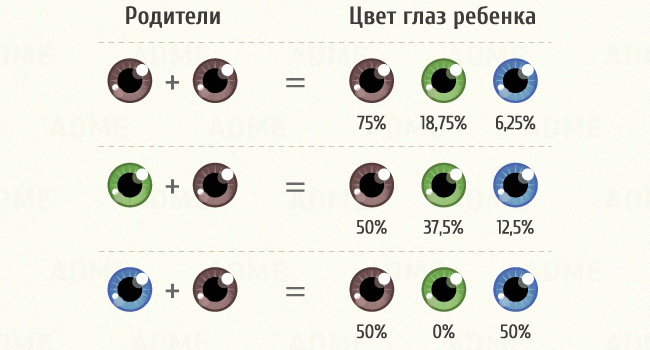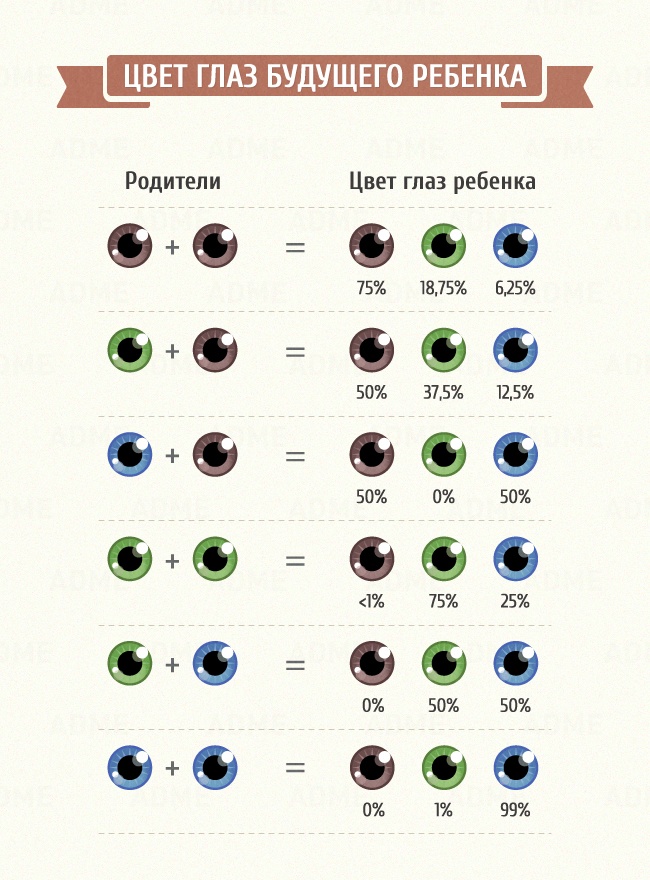How the color of the eyes is transmitted from the parents to the child. Calculate the color of the child's eyes.

The color of the eye is a characteristic determined by the pigmentation of the iris. The color of the eyes is a fascinating and interesting topic that has fascinated numerous researchers for centuries, until science helped us to better understand the nature of the origin of eye color, and most importantly - how it is inherited.
When it comes to predicting the color of the child's eyes, one thing is certain - the baby will be born with blue eyes. Almost always, the eyes of newborns have a blue color, which subsequently darkens as it is exposed to sunlight. Approximately to three-four years the child's eyes usually get their permanent color remaining for life, whether it is blue, green, brown, amber, gray, dark brown or even dark red .
We hope that future parents will use this article as some help in determining the color of their kid's eyes. It does not matter whether you go deeper into the scientific theory of predicting the color of the eyes of children, these tips are intended to provide an excellent basis for determining the color of the child's eyes for future mothers and dads. Use it as an assistant to the emergence of an informed forecast based on long hours of research.
Definition
Iris consists of anterior - mesodermal , and posterior - ectodermal layers.
The anterior layer consists of the outer border and stroma. Chromatophores containing melanin are distributed in it. The color of the eye depends on the nature of the distribution of pigments in this layer.
The back layer contains many fuscine-filled pigment cells. Regardless of the color of the eyes, the back layer has a dark color, except for only albinos. In addition, the role played by the vessels and fibers of the iris.
Inheritance of eye color from the point of view of science

The question of the color of the eyes and how it is transmitted from parents to offspring has been the subject of numerous debates among experts in the field of genetics for many years. There is a well-established opinion that the color of the child's eyes is inherited according to the laws of Mendel. According to this law, the color of the eyes is inherited in almost the same way as the hair color: dark-colored genes are dominant; The distinctive features (or phenotypes) encoded by them take precedence over the distinctive features encoded by the lighter color gene.
At parents with dark hair, most likely, and children will be with dark hair; Descendants of fair-haired parents will be blonde; And the child of parents, whose hair color is different, will have hair whose color will be somewhere in the middle between the parents. Of course, there are exceptions, but there are also the regularities of the processes described by Darwin, Lamarck and Mendel a century ago. There are also rules that describe code and inheritance for most genes.
Some funny facts about the color of the eyes
1You probably know that the most common eye color in the world is brown, but do you know that the rarest eye color is green? In fact, less than two percent of the world's population has green eyes. If we talk about countries separately, Turkey has the highest percentage of citizens with a green eye color, namely: 20%. There is also a certain number of countries located mostly in Asia, South America and the Middle East, whose residents have almost no green eyes.
2Did you know that for the Caucasians the blue color of the eyes is the most characteristic, not counting amber, brown, gray and green? Also, more than 80% of the inhabitants of Iceland have eye color either blue or green.
3Not often occurring, but very noticeable phenomenon, called heterochromia, leads to the fact that the eyes of a person have a completely different color. American actress Mila Kunis, known on the series "Show 70's" and "Family Guy", one eye blue, the other - green. Kate Bosworth, who played in the films "Blue Wave" and "Return of Superman", both eyes are blue, but the lower part of the right eye contains a large incrustation of brown color. David Bowie, author of hits "Ziggy Stardust" and "Labyrinth", perhaps the most famous celebrity with a mismatched eye color. However, few people know that the difference in color of Bowie's eyes is the result of a trauma he received during adolescence during a game of football, and not heterochromism.
Tables for calculating the color of the future child's eyes
The color of the eyes from grandparents - to our grandchildren is transmitted genetically.

The color of the eyes from grandparents - to our grandchildren is transmitted genetically. During pregnancy, many parents are eager to know what color their child's eye will have. All the answers and tables for calculating eye color are in this article. Good news for those who want to transmit to their descendants is their eye color: it's possible. Recent research in the field of genetics has revealed new data on genes that are responsible for eye color (previously there were 2 genes responsible for eye color, now there are 6 of them). At the same time, there are no answers to all questions about the color of the eyes of genetics for today. However, there is a general theory, which, even with the latest research, provides a genetic justification for eye color. We will consider it.
So: each person has a minimum of 2 genes determining the eye color: the HERC2 gene located in the human 15 chromosome , and the GEY gene (also called EYCL 1 ), which is located in 19 chromosomes .
Consider HERC2: a person has two copies of this gene, one he receives from his mother, one from his father. HERC2 is brown and blue, that is, one person has either two brown HERC2 or two blue HERC2 or one brown HERC2 and one blue HERC2:
Gene HERC2 2 copies *Brown and BrownBrown and Blue Blue and Blue |
Color of human eyesBrownBrown Blue or Green |
* In all tables of this article, the dominant gene is written with a capital letter, and the recessive gene is written with a small one, the color of the eyes is written with a small letter.
Whence comes the owner of two blue HERC2 green eyes - explained below. In the meantime, some of the data from the general theory of genetics: HERC2 is dominant, and blue is recessive, so the bearer of one brown and one blue HERC2 will have a brown eye color. However, to its children the bearer of one brown and one blue HERC2 with the probability of 50x50 can transmit both the brown and the blue HERC2, that is, the dominance of the brown does not affect the transfer of the copy of HERC2 to the children.
If the wife has brown eyes, even if they are "hopelessly" brown - that is, she has 2 copies of the HERC2, all children born with such a woman will be brown-eyed, even if the man has blue or green eyes, as the children will give it to her. One of his two brown genes. But grandchildren can have eyes of any color.
For example:
HERC2 from mother - hari (mother, for example, both HERC2 brown)
HERC2 from the father - blue (for the father, for example, both HERC2 blue)
HERC2 in a child - one brown and one blue. The color of the eyes of such a child is always brown; While his blue HERC2 he can pass on to his children (who can also get a blue HERC2 from the second parent and then have either blue or green eyes).
Now let's move on to the GEY gene: it is green and blue (blue, gray), there are also two copies of each person: one receives a copy from the mother, the other - from the father. The green gey is the dominant gene, the blue gey is recessive. A person thus has either two blue gey genes or two green gey genes or one blue and one green gey gene. At the same time, this affects the color of his eyes only if he has HERC2 from both parents - blue (if at least from one of the parents he received a HERC2 brown eye, his eyes will always be brown).
If a person received a blue HERC2 from both parents, depending on the gey gene, his eyes can be of the following colors:
Gene GEY: 2 copies
- Green and Green
- Green and blue
- Blue and blue
Color of human eyes
- Green
- Green
- Blue
The general table for calculating the eye color of the child, the brown eye color is indicated by "K" , the green color of the eyes is indicated by "Z" and the blue color of the eyes is indicated by "G" :
| HERC2 | GEY | Colour |
|---|---|---|
| QA | PP | Brown |
| QA | 3g | Brown |
| QA | Gg | Brown |
| Kg | PP | Brown |
| Kg | 3g | Brown |
| Kg | Gg | Brown |
| The | PP | Green |
| The | 3g | Green |
| The | Gg | Blue |
Using this table, we can say with a high degree of probability that the child's eyes will be green, if both parents have green eyes or one of the parents has green eyes, and the second has blue eyes. You can also say for sure that the child's eyes will be blue, if both parents have blue eyes. In the event that at least one of the parents has brown eyes, their children may have brown, green or blue eyes.
Statistically:
- In two brown-eyed parents, the probability that the child will have brown eyes is 75%, green - 18.75% and blue - 6.25%.
- If one of the parents is brown-eyed, and the second - green-eyed, the probability that the child will have brown eyes is 50%, green - 37.5%, blue - 12.5%.
- If one of the parents is brown-eyed, and the second - blue-eyed, the probability that the child will have brown eyes is 50%, blue - 50%, green - 0%.
Thus, if a child has eyes that are not of the same color as his parents, then there are genetic reasons and justifications, because "nothing disappears without a trace and nothing is taken from nowhere"
Primary colors
Blue eye
The outer layer of the vessels of the iris, formed from collagen fibers, is dark blue. If the fibers of the outer ectodermal layer of the iris differ by low density and low content of melanin, then it has a blue color. In the iris and in the eye there are no blue or blue pigments at all. Blue is the result of light scattering in the stroma. The inner layer of the iris, unlike the outer one, is always saturated with melanin and has a black-brown color. As a result, a part of the high-frequency component of the light spectrum incident on the eye is subjected to scattering in the turbid environment of the stroma and is reflected, and the low-frequency component is absorbed by the inner layer of the iris. The smaller the density of the stroma, the more intense the blue color. Such a color has many babies in the first months of life.
Blue eye
In contrast to blue eyes, in this case the density of collagen fibers of the stroma is higher. Since they have a whitish or grayish hue, the color will be no longer blue, but blue. The higher the density of fibers, the lighter the color. The blue color of the eyes is the result of a mutation in the HERC2 gene, which causes carriers of such a gene to reduce the production of melanin in the iris of the eye. This mutation appeared about 6-10 thousand years ago. Blue and blue eyes are the most common among the population of Europe, especially in the Baltic and Northern Europe. In Estonia, 99% of the eyes have such a color of eyes, in Germany - 75%. In Denmark in the 1970s, the dark eye color was only 8%, whereas now, as a result of migration, this figure has increased to 11%. According to a 2002 study, among the European-American population of the United States, born in 1936-1951, blue and blue eyes are 33.8%, while among those born in 1899-1905, this figure is 54.7%. According to 2006, this figure for modern white Americans fell to 22.3%. Blue and blue eyes are also found in the Middle East, for example, in Afghanistan, Lebanon, Iran. They are also distributed among Ashkenazi Jews, for example, among Ukrainian Jews, the percentage of carriers of these flowers is 53.7%.
Gray eye (steel hue)
The definition of gray and blue eyes is similar, but the density of fibers of the outer layer is even higher and their shade is closer to gray. If the density is not so great, then the color will be gray-blue. The presence of melanin or other substances gives a small yellow or brownish admixture. The gray color, presumably, is related to the scattering of Mie by the fibers of the outer layer, which, unlike Rayleigh, is less dependent on the wavelength; As a consequence - the spectrum of light reflected from the iris is closer to the source spectrum than in the case of blue or blue eyes. The gray color of the eyes is most common in Eastern and Northern Europe. In Russians this color, according to 1909, reached 50%. It also occurs in Iran, Afghanistan, Pakistan and some regions of North-West Africa.
Green eye
The green color of the eyes is determined by a small amount of melanin. In the outer layer of the iris, yellow or light brown pigment lipofuscin is distributed. In the sum with the resulting blue or blue color in the stroma, the result is a green one. The color of the iris is usually uneven and there are many different shades. In its formation, perhaps, the gene of red hair plays a role. Pure green eye color is extremely rare. Its carriers are found in Northern and Central Europe, less often in Southern Europe. According to adult studies in Iceland and the Netherlands, green eyes in women are more common than in men.
Amber Eye
Amber eyes are monotonous light yellow-brown in color. Sometimes they are characterized by golden-green or
Swamp Eye
Swamp green Swamp color of eyes is a mixed color. Depending on the lighting, it can have a golden, brownish-green, brown hue. In the outer layer of the iris, the melanin content is rather moderate, so the marsh color is obtained as a combination of brown that gives melanocytes, and blue or blue. There may be yellow pigments. Unlike amber, in this case the color is not monotonous, but rather heterogeneous. In some cases, the eye color may appear not so much as marsh (brown-green), as light-brown with a yellow-green hue, so in the English tradition it is called hazel, and in Polish it is piwny.
Brown eyes
In this case, the outer layer of the iris contains a lot of melanin. Therefore, it absorbs both high-frequency and low-frequency light, and the reflected light in the sum gives a brown light. Hazel is the most common color of the eyes in the world. It is widespread in Asia, in Oceania, Africa, South America, and also in Southern Europe
Black eye
The structure of the black iris is similar to brown, but the concentration of melanin in it is so great that the light falling on it is almost completely absorbed. In addition to the black iris, the color of the eyeball may be yellowish or grayish in color. This type is prevalent, primarily among the Negroid race, in South, Southeast and East Asia. In these regions, newborns are immediately born with a melanin-rich iris.
What will your future child look like (Infographics)
Who will your children look like - it's incredibly curious to know, is not it? Science in our time works wonders and can easily predict which family traits will be passed on to the future baby.
The AdMe.ru site analyzed genetic patterns and compiled approximate portraits of children from parents of different types of appearance.













Comments
When commenting on, remember that the content and tone of your message can hurt the feelings of real people, show respect and tolerance to your interlocutors even if you do not share their opinion, your behavior in the conditions of freedom of expression and anonymity provided by the Internet, changes Not only virtual, but also the real world. All comments are hidden from the index, spam is controlled.